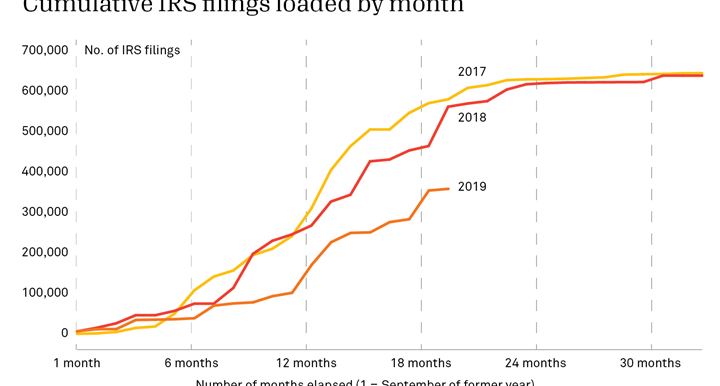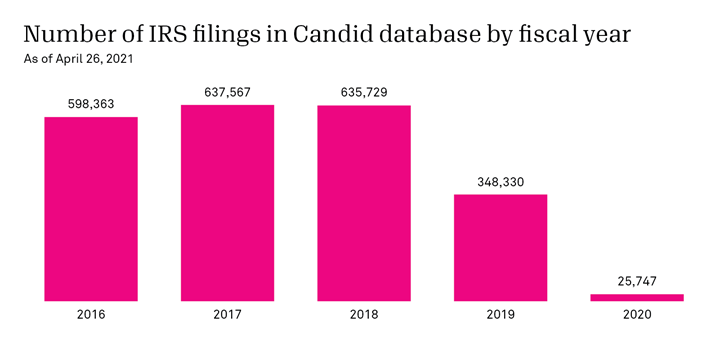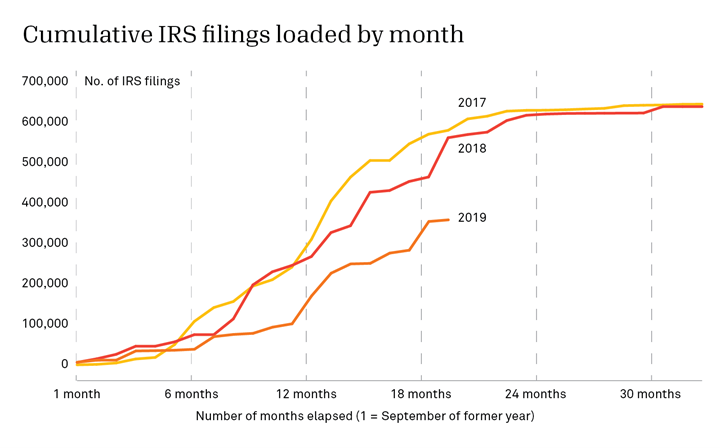Where are the 2019 (and 2020) 990s? On filling the gaps in Candid’s grants data

People often ask us, “When will the [year just passed] 990s be available?” Because of the way Form 990 deadlines work, the answer is complicated. There’s no universal date for filing 990s; instead, the end of an organization’s fiscal year determines when its 990 is due at the IRS. Add in six-month filing extensions and IRS processing time, and it can be two years before we receive all the returns for a specific year.
This year, another factor is in play: backlogs created by COVID-19. To date, there are still millions of returns from 2019 that have not yet been processed. This gap is notable because IRS 990 filings are a substantial source of data about nonprofits and foundation grantmaking in the U.S. At Candid, grants data from 990s flows into tools such as Foundation Directory, public dashboards that provide insights into philanthropy in different regions across the U.S., and several issue- and location-specific Foundation Landscapes. Sourcing grants data from 990s isn’t ideal to begin with—grant descriptions from filings are often sparse, and sometimes grants lists are missing entirely. And two years is already a long time to wait for this information. The additional delays exacerbate this issue.
The IRS isn’t Candid’s only source of data, but it’s an important one
To be sure, Candid doesn’t depend exclusively on IRS data. In addition to IRS filings, we collect data about the nonprofit sector and foundation grantmaking from the organizations themselves as well as other publicly available sources. (Our executive vice president, Jacob Harold, wrote about three sourcing methods we use to collect grants data—IRS filings, direct reporting, and web scraping—on the Candid blog.) To date, we’ve collected data on more than 125,000 grants for 2020 and 2021, most of it from non-IRS sources. Our investment in efforts to collect more real-time data has enabled us to provide the field with insights into the philanthropic response to such crises as the COVID-19 pandemic and the ongoing struggle to achieve racial equity and racial justice.
Although real-time grants data is in high demand, “old” IRS 990 data still matters, for two related reasons. First, it is comprehensive; all foundations and grantmaking public charities are legally obligated to disclose data about their grantmaking. By necessity, our most recent grants data is limited to what’s been shared directly with us or made public. Second, 990 data provides context. Inevitably, when people see data about what grantmakers are doing “today” (or as close to today as we can get!), they want to know how it compares to what happened before: “How does the response to the COVID pandemic compare to the response to previous crises, like the Ebola outbreak?” “Are funders providing more general support than in previous years?” “How has funding for Black communities changed since George Floyd’s murder?” Having comprehensive data is what allows us to answer these types of questions with confidence.
A status update on filings
The pace at which the IRS releases 990 data has slowed over the last several years. COVID-19 has exacerbated the problem, especially for 2019 and 2020 data. As the charts below illustrate, we’re far from having comprehensive data for 2019, let alone 2020. And the rate at which we’re receiving 2019 filings has slowed, compared with 2018 filings (and 2018 was somewhat slower than 2017). As of April 2021, we’ve collected 348,330 filings for 2019, about half of what we expect to collect overall and 37 percent fewer than we had at the same point last year for fiscal year 2018.[1]


What the slowdown means for Candid’s data, how we’re responding, and how you can help
Although these delays have implications for all Candid products, they also have a significant impact on our research. They impede the creation of our annual Foundation 1,000 data set, which combines all grants awarded by 1,000 of the largest U.S. funders. This is the data set we, and others, use to derive information about trends in grantmaking, such as on racial justice in education or funding for disasters.
We don’t expect the issue of delayed filings to go away quickly. In fact, we anticipate that, despite the new requirements for filing 990s electronically, we may feel the effects of reduced IRS processing capacity for the next couple of years. We’re addressing the slowdown in a couple of ways:
- Exploring new methods to allow us to draw valid insights on changes in grantmaking. We recognize the urgent interest in analyses of how things have changed in the past year. We’re exploring ways to adjust our methods to work around the delay and meet the demand for this research.
- Continuing to encourage funders to share their grants data directly with Candid. More than 900 funders globally share their grants data with Candid, either directly or via our partners. Candid is currently collecting data on FY20 and FY21 grants to date by June 30, 2021. Funders can contact us at [email protected] to learn how to contribute data to provide a clearer picture of what’s being funded and by whom.
Candid exists to get organizations and individuals working in the social sector the information they need to do good. The demand for that information is varied and vast, as are the challenges in providing it. Candid continuously adapts the way we work to address these challenges. As with most problems in the sector, though, the gaps in data caused by limited IRS capacity are not something one organization can fix alone. Good decisions require good information. We’re calling on organizations in the sector to recognize the important role they can play in making sure that information is available sooner rather than later, now versus too late.
______________
[1] Form types captured in these counts include 990s, 990-EZs, and 990-PFs, filed either electronically or as paper documents. We consider 2018 to be our latest “complete year” of data and would expect to see comparable figures for 2019 and 2020 once collection is finalized. The trendline for 2019 represents filings collected through April 2021.







Sanna Roling says:
I represent on Platinum charity that uploads a copy of our 990 the day I send it off to the IRS. Starting with 2020 990 (filed it April 14, 2021) I have to efile. Chose a particular company - efile- that's free to me until our organization grows bigger. They did such a good job of asking for data and inputting it that from now on I'll not have math errors, I intend to stay with them even when I have to pay to file. The upload to the IRS happened less than 24 hours before I got confirmation that the IRS had my 990. In turn, I learned recently that it took the IRS until May 15 to formally make my 990 public.
Love GuideStar.